Nagla Block (
wikimapia) is the northern range of Sanjay Gandhi National Park (
SGNP), separated from the main park by Vasai Creek. It is one of my favourite destinations around Mumbai (read the 2009 article
here). This article is about my visits to Nagla Block in year 2007, when my camera was a month old and my blog yet nonexistent. Let’s revisit this place and look at the pristine forest of Mumbai that is a hot destination of naturalists and photographers.
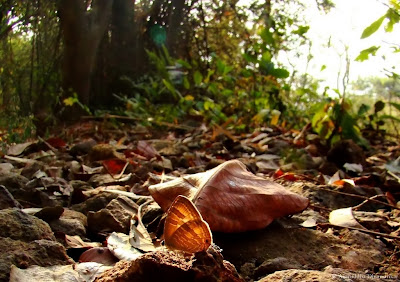 |
| A Common Cerulean, Jamides celeno rests against early morning sunlight |
It is only a small portion of SGNP, but it is of prime importance to the wildlife of Mumbai and the surrounding areas. It is the only corridor joining SGNP with other Protected Areas to the north. If you take a look at the
map of SGNP, south is a dead-end to all of wildlife, and it is here that many man-animal conflicts, especially with leopards, occur. The
east and
west of SGNP are also arrested by urbanization, and it is here that encroachment is most concerning. This leaves Nagla Block, the north-end of SGNP as the only escapade for wildlife, especially for large mammals. Further north lay Tungareshwar Wildlife Sanctuary (which I covered in my
first article in 2008) – another pristine protected area of northern Western Ghats. And beyond Tungareshwar lie many fragmented patches of forestland.
Nagla Block has been in news for a few reasons, once for a supposed tiger sighting as well as countless other leopard sightings, but it is more sought after by naturalists for its bird and insect diversity. This part of the park has only one legal entrance into the forest, and it is almost always guarded, hence seeking entry without permission can be difficult. Many naturalists find this outrageous, because they’re only going into the forest to observe nature, but then there are those who enter the park to drink and to litter, which is one of the reasons why the guards don’t entertain any people without permission. But don’t get me wrong, these guards, who always come to the guardhouse later in the noon for their own reasons, are very friendly.
Being closer to the creek, the fringes of Nagla Block are rich wetlands consisting of freshwater streams and brackish waters. It is here that the diversity is at its best, for the deciduous forests mix with mangrove wetlands, rich in soil and plant matter. Nature walks here usually last for most of the day, as the paths tread through teak woods and sporadic bamboo patches probably planted in the past, to the wetlands full of natural activity. On these trails, I was the one who always had his head down, exploring the leaf litter and thickets for insects and spiders. And in this lush green forest, in the month of December, I found butterflies and saw spiders that I had never seen before.
It is here that naturalists have discovered rare butterflies for Mumbai region, such as the Redspot (the paper can be accessed
here) along with the White Tufted Royal and birds like Oriental Dwarf Kingfisher (a recent sighting of Common Tinsel, a lycaenid has also been
recorded). While I haven’t been fortunate to observe these rarities, it was amazing to observe butterflies in huge numbers, with the species count going well over 70 in a day!
 |
| Common Emigrant, Catopsilia pomona butterflies puddling on the banks |
As many Pierids were busy gaining minerals from the damp ground such as these Common Emigrant butterflies, Nymphalids like the beautiful Gaudy Baron occasionally visited wet patches for their share. The entire butterfly and most moth families are known to engage in mud-puddling, where they obtain minerals and amino acids required for reproduction that cannot be acquired from a nectar diet. It is mostly conducted only by males, and the males present it to the females as a nuptial gift. This is a great strategy probably because a mud-puddling butterfly is very easy to prey upon, hence females which have to spend energy nurturing and laying eggs, would rather not risk being vulnerable to predators, and thereby succeed in continuing with the progeny.
 |
| A female (left) and a male (right) Gaudy Baron, Euthalia lubentina |
One of my favorite butterflies is the Gaudy Baron. Although common in SGNP, Nagla Block is the best place to observe it. It was here that I first observed it, and haven’t been lucky since to get a decent photograph.
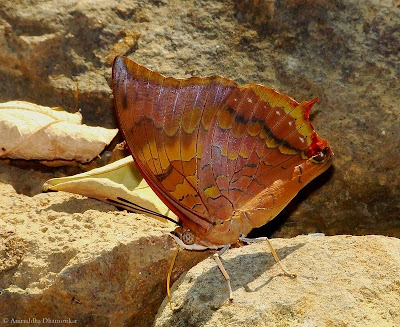 |
| Tawny Rajah, Charaxes bernardus on a dry stream bed |
There are also other Nymphalids that zoom across the stream or occasionally swoop down on the banks for a sip or two of the nutrient rich soils – these superfast fliers are the Leafwings – the
Charaxes and the
Polyura (read the article about Chraxes
here). Nagla Block is again the best place to observe these Nymphalids in Mumbai. My first ever sighting of a Common Nawab was obscured by many plants, as it preferred perching high in the canopy, but one day while exploring the creek side, we were visited by a thirsty Common Nawab as well as a Tawny Rajah – a blessing for any amateur butterfly watcher!
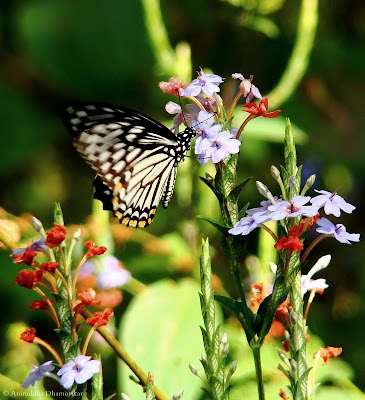 |
| Common Mime, Papilio clytia, dissimilis form |
Amongst other Nymphalids, the most common were the Tigers and Pansies. And as I happened to be stalking a Blue Tiger butterfly, I saw a rather larger specimen fluttering over
Eranthemum flowers. It was not hard to tell that it was a Common Mime, dissimilis form, a mimic of the Blue Tiger, which is not so common in the dry season.
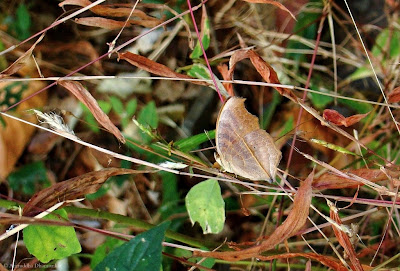 |
| Peacock Pansy, Junonia almana blends in with the undergrowth |
The Pansies are one the first few butterflies learnt by any budding naturalist, and this is the place where you can observe most of them within a few minutes of entering the forest. They are the perfect example of coordinated showy upper-wings with contrasting dull under-wings – as is shown by this Peacock Pansy that is well known for its bright orange upper-wings with large beady eyes. In the dry season, the colours on the under-wings match the dried vegetation perfectly. There are other cryptic butterflies such as the Bamboo treebrown that prefer to rest on the dried leaf litter – a perfect camouflage, and there were those that would prefer to flaunt their colours in the same habitat – such as the Common Baronet and the Commander.
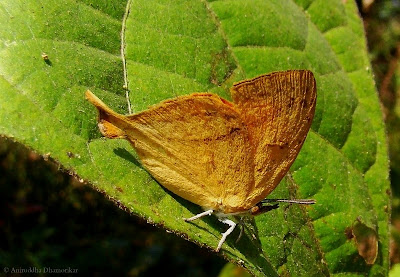 |
| Yamfly, Loxura atymnus |
Besides Nymphalids, that were the most abundant, there were many Lycaenids that would join in for mud-puddling as well. One of my favourites – the one which I have only seen at Nagla Block is the Yamfly. It is probably the most brightly coloured Blues of Mumbai. With a brilliant orange under-wing coat and a splendid tail, it has deep red upper-wings, which it only rarely opens – such as while basking in the early morning sun. The specimen we saw was tattered, but a beauty none the less. Thanks to my minimal photography skills, I could manage a record photograph, and keep hoping to come across one again ever since. Lycaenids such as Grass blues are very common throughout Nagla Block, but the best place to observe them has to be near a water body. We stumbled across many Lycaenid species along small streams than anywhere in the forest. From butterflies like the Guava Blue and Leaf blue, to large Oak blues and the Cupids such as Plains Cupid and Indian Cupid, Nagla Block was probably the place to hit to party if you were a Lycaenid too!
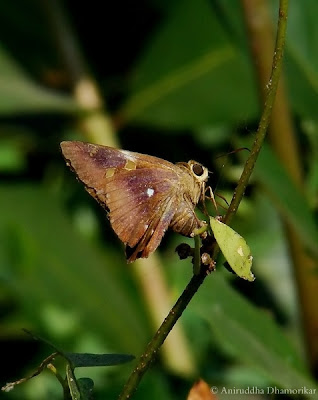 |
| Common Awl, Hasora badra laying eggs |
And how can I forget my most favourite family – the Hesperiidae. Since we were out in December, much later after the Hesperiid season, we were surprised by a tiny Common Awl that decided to lay eggs on a plant, probably
Pongamia sp. (visit
Butterflies of Singapore to see its lifecycle). Although ‘common’ in its name, this is a not-so-common species of Mumbai. There were very few Skippers around, but the commonest of all was the Spotted Small Flat.
 |
| Handmaiden moth, Euchromia sp. pair |
Some of the most eye-catching bugs around were the day-flying moths –
Euchromia sp. (
polymnea or elegantissima?), commonly called Handmaiden moth. I don’t know the reason for such a common name, but it has several other names – such as day-flying moth because they’re out and about throughout the day, or Wasp moth – because of their superficial likeness to a wasp, something observed in many species in the family Arctiidae. There were many individual moths feeding on flowers alongside butterflies, as well as some mating in large numbers. It is a common moth of SGNP, along with several of its cousins (
Amata sp.) belonging to the same family.
 |
| A Broad-headed bug nymph that mimics an ant |
Although I observed very few other insects and could photograph only a fraction of them, there were several bugs such as the ant-mimicking Alydidae nymphs and well camouflaged Katydids in their dry season colouration. It is very interesting to observe the impact of weather on the survival of the insects. In the case of Hemipterans, many species sporting a green-colour occur commonly during monsoon, most likely because of fresh foliage around. As the drier season follows, many of these green-coloured bugs may have finished their lifecycle by laying eggs that will hatch only during next monsoon. During this dry season, many brown-coloured bugs become more common than the green ones. This synchronous cycle of bugs not only helps them hide better and therefore survive, but also reduces the competition between multiple species. While many animals do synchronize their lifecycle with several other plants or animals, some, such as the Orthopterans – Grasshoppers, Crickets and Katydids change their colour to match with the surrounding. Hence, a single species will show a brilliant green, to golden yellow, to dark brown colouration depending upon the season. What’s great about such behavioural observations is that they can be made over several years in any forested areas, and we can probably study a trend, or a change, perhaps linked to human-induced climate change.
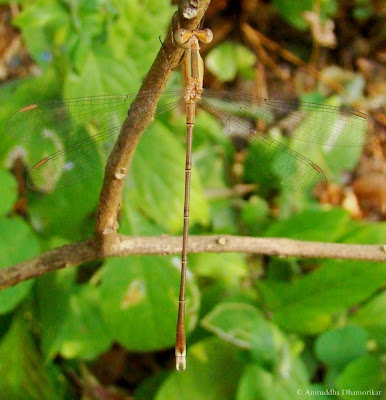 |
| Emerald Spreadwing, Lestes sp. |
Since there was an abundance of the many plant-feeding insects as well as parasitic mosquitoes around, there were those who would gladly feast on them, add a bit of stagnant water ponds, and the Odonates will be happy as ever in the dry season. The most common Odonate of Nagla Block was – and still is – the Emerald Spreadwing –
Lestes sp. These rather large damselflies are surprisingly common than dragonflies even during the dry season. These Spreadwings, although common throughout Mumbai, are only common locally. For example, one is bound to see them in vast numbers at Nagla Block than at the southern part of SGNP. I don’t know the reason why, but considering their numbers, they easily hold a similar niche of being at top of an insect food pyramid at Nagla Block as a dragonfly holds anywhere else.
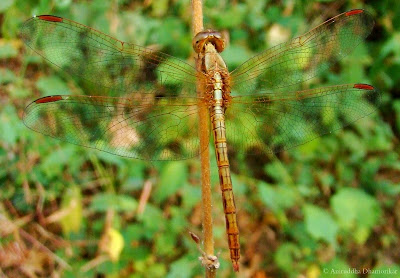 |
| Neurothemis sp. (intermedia?) |
The only dragonfly that I came across was most likely a
Neurothemis sp. (
intermedia?) that preferred to rest on the forest path close to a small Oriental Garden Lizard,
Calotes versicolour. Although I have not observed Odonates at Nagla Block, given its pristine habitat and availability of water, I expect a healthy number of species, probably more than those in the main park.
 |
| Ant mimicking spider, Myrmarachne sp. |
Spiders are also very common at Nagla Block. With thorny Lynx spiders hiding under leaf surfaces – probably hiding from the intense sunlight, there are others rather active spiders lurking in the bushes and the forest floor. These are the Wolf spiders and Jumping spiders, and we’re looking at a special Jumping spider, the one the closely mimics in looks as well as movement, an Arboreal bi-coloured ant –
Tetraponera rufonigra. This individual was a female, easily identifiable by the absence of large pedipalps in front of the head. We did not witness how she caught the Tiny Grass Blue butterfly, but she seemed to have got hold of only its wing. Sooner, she must have realized that her hunt wasn’t successful, but she wouldn’t have given up so easily.
Nagla Block surprised me with its sheer biodiversity at the dry time of the year, and I can only imagine the treasures it hides high in the canopy and deeper into the woods. If SGNP is the breathing lung of Mumbai, Nagla Block is most definitely the heart that provides a passage for the wildlife to enter and exit SGNP, enabling genetic flow between species, and especially large mammals. Without Nagla Block, I cannot imagine a future for the most beautiful predator of Mumbai – the Leopard. And without Leopards, I cannot see respect in the eyes of those who illegally destroy forests. Recently, a freight railway plan was given a ‘go’ to further fragment the forests at Tungareshwar Wildlife Sanctuary. It is such big projects that are devastating to the wildlife, but as more and more citizens become aware of the importance of this wildlife corridor, I hope to see many more discoveries and conservation measures in the future.













Great post Aniruddha! I enjoyed watching and reading your post. Nagla Block is looking a place of possibilities, a paradise of biodiversity.
ReplyDeleteJust loved gazing at your pictures. The macro world is amazing.
ReplyDeleteWill be visiting "Nagla Block" on Sunday(10-7-2011) with "B.N.H.S Group" of naturalists. Thanks to your blog, got some knowledge about these forests.
ReplyDeleteThank you. Keeping my fingers crossed for this weekend.
ReplyDeleteHi. Very Informative post, really helpful.
ReplyDeleteI just have one query. In the image of 'A Broad-headed bug nymph that mimics an ant', the insect is sitting on a plant which has brown color fruits with small spikes on them. By any chance, do you know which plant it is? I had a short visit to western ghats area near Mangalore. I have taken few pictures of insects on the same plant. I wanted to know about that plant but could not able to search it in net. Please help.
-Shashwat
Thank you Shashwat. The plant is called Urena lobata.
DeleteHi Aniruddha,
ReplyDeleteThanks for a lot of information. Could you also tell me how to seek permission if I want to visit Nagla block with my family and not with any group like the ones from BNHS ?
Thanks,
Kalpesh
Dear Kalpesh, thanks for visiting. You can get official permission from the office of forest dept of SGNP located near the Borivali gate. I will recommend going with someone who knows the forests.
Deletehi could you please revert if there are any groups going tomorrow?
DeleteBrilliant article!!!
ReplyDeleteVery informative! Kudos to the research that you did. Would like to know whether you are a zoology student or a very knowledgeable nature enthusiast? Please follow me on Facebook Anurag Karekar. We will have lots in common to talk about!